Running and Africa are almost synonymous, at least at the elite level with talented Kenya and Ethiopian runners training at altitude, breaking records, dominating the world stage. In South Africa, the Comrades Marathon is the world’s oldest and largest ultramarathon. Held annually in the KwaZulu-Natal province of South Africa between the cities of Durban and Pietermaritzburg, it is an almost 88km (55-mile) race. There’s the “Up Race” and the “Down Race,” as the course alternates start/finish every other year, making it more challenging for those wanting to run it more than once. This would have been on a list of races to run at one point in my life, likely not now.
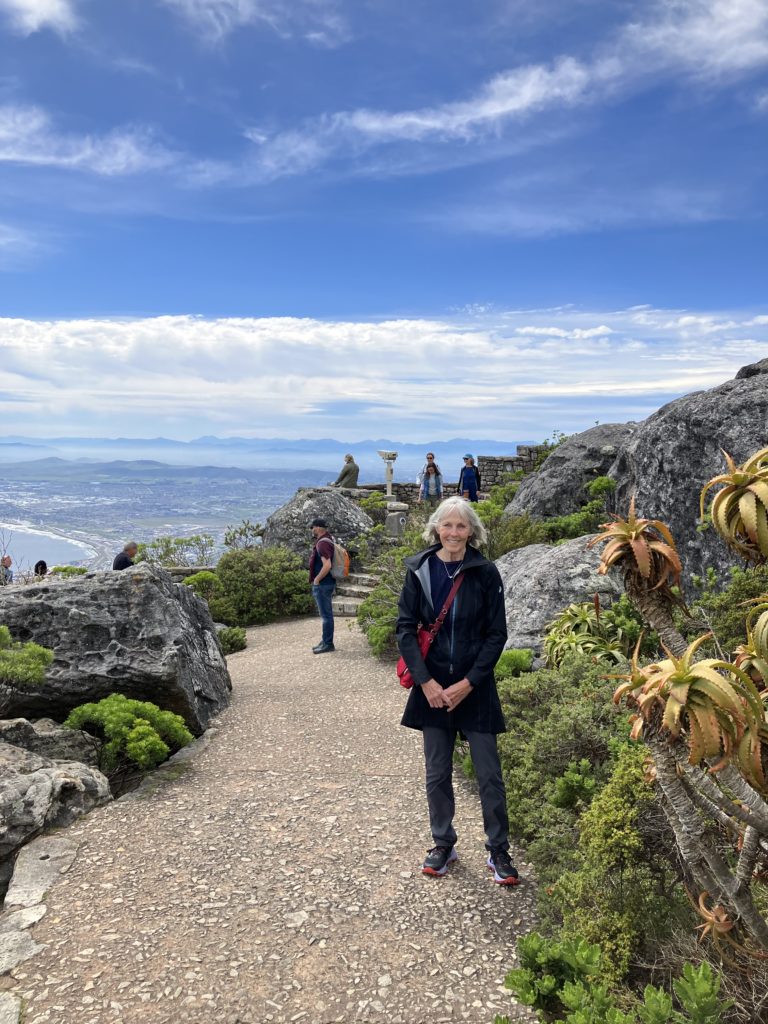
For the ordinary runner like me, trying to figure a way to do some running during a two-week retreat to South Africa was not easy. My days at home begin with motion, watching the sky lighten, smelling the seasons, having time to myself. The retreat was an extraordinary opportunity to explore four unique areas of South Africa, surely I could survive without my daily run. Yet I fretted as running, being active, moving, are vital to my physical and mental well-being. What a problem to have, right? I depend on some stability even as I challenge myself to do things that might be uncomfortable or different. I’ve rarely gone on an “almost solo” trip, without family, to such a far region, with the world in a state of flux. Running was my planned anchor even as I reveled in the unique experiences South Africa promised to me and my travel companions.
Travel and running have unique challenges: finding a safe place to run; the time change difference (South Africa is six hours ahead of North Carolina); my best sleep is in the early morning hours, which is my traditional running time, but perhaps not the best time to run in a new locale; a touring schedule that had us up early each day; and unpredictable weather. I needed the discipline and courage to find the right space to run, even if that meant embracing the surprises each place might bring.
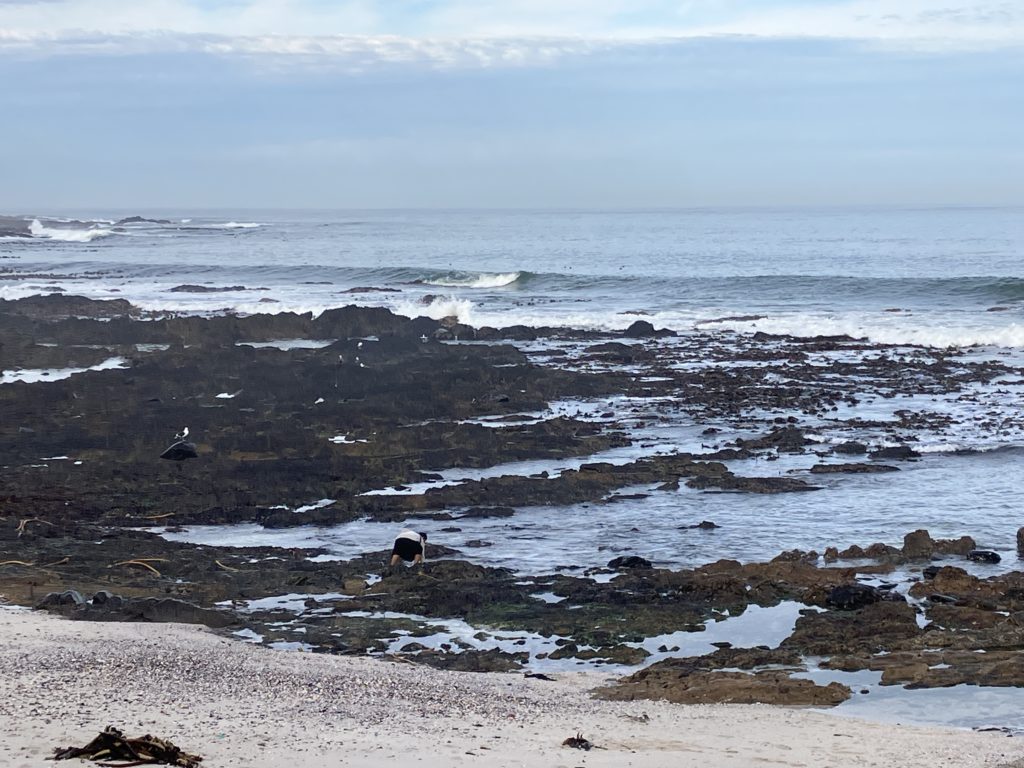
Tide pools near the sea wall along the Sea Promenade, Cape Town
South Africa is a country of contradictions, the utmost beauty of the oceans and bays, the mountains, the valleys, and the vastness and immensity of the bush, juxtaposed against the harsh reality of extreme poverty, metal shanty towns (euphemistically known as “temporary settlements”), immigrants from other African countries living on the streets, warming themselves by fires at night, no running water or sewage facilities, rampage thief, dangerous city streets. I would be foolish to think that an older, white woman, would be safe, running streets alone, so I had to make thoughtful choices.
I’d read about the Sea Promenade in Cape Town as a potential running spot while we were there. It is nearly eight miles of a paved walking/running/bicycling path next to the sea wall, with whimsical public art, children’s playgrounds, and an old light house on the city side of the path. Only a few blocks downhill from our guest house, I designated it as my Cape Town running destination running.
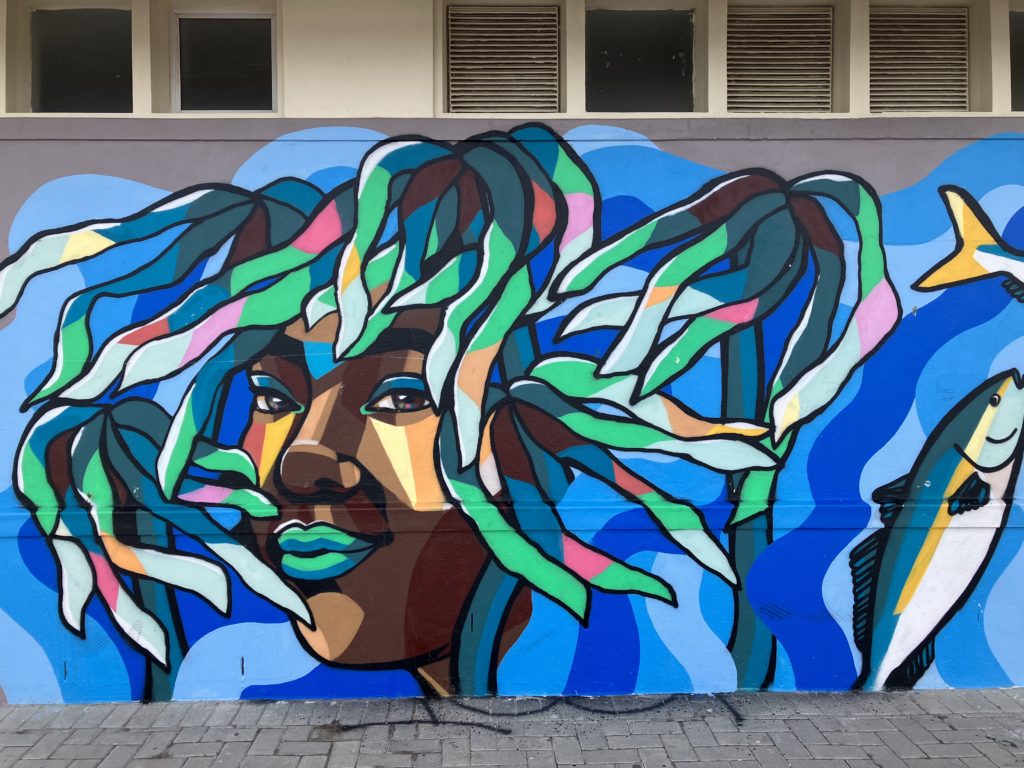
Art on the side of one of the buildings along the Promenade
I forced myself awake the first morning after arrival. I hadn’t slept well, jet lag wreaking havoc with sleeping, but knew I needed to move before our packed day of touring. I slipped out of the house at 6:30 just as the security guard arrived (de rigueur at most places we stayed). The morning was chilly and damp. The bay breeze was stiff, the ocean choppy and gray, the tide pools covered with frothy waves. There were a few hardy souls walking, arms held tightly around their jackets, steaming cups of coffee in hand. I also noticed a few other intrepid runners, braving the winds and early light. Ocean smells wafted in the air as I tried to shake loose my body’s stiffness from the previous day’s 15-hour plane flight. Although I ran only a few miles, slowly, my legs sluggish, my breathing shallow, I was invigorated (even a bad run is good!). A perfect beginning to this long-awaited journey to Africa.
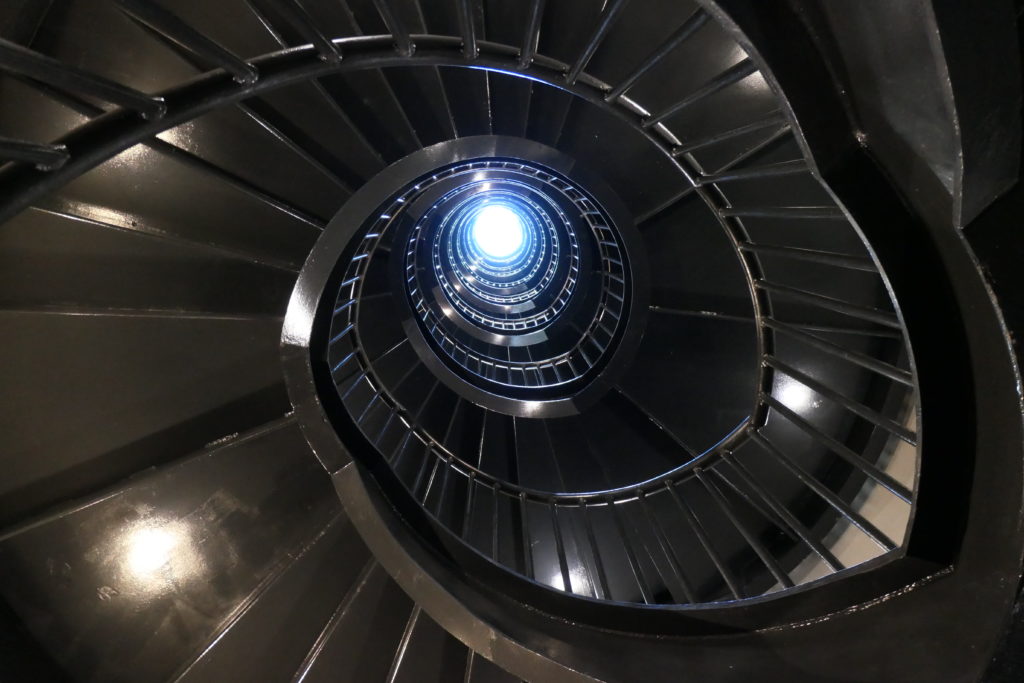
Inside Zeitz Museum of Contemporary Art (a repurposed grain silo), Cape Town
Our second morning in country: same time, same place, same distance. A little different, though, for when I turned at the light house, the deluge hit: heavy raindrops quickly soaked my entire body. Nothing to do but to keep running until I returned to the warmth of our guest house. I was completely drenched, my hair dripping, my clothes sopping wet, my shoes (not waterproof) squishy. Always easier to stay in bed, I’m glad I forced myself out, even knowing it might rain. My body knew I needed this respite (yes, even running in the rain can be a respite) before a busy day of touring botanical gardens, driving along the Western Cape, eating (ah, so much good food), and strolling in charming fishing villages.
Our days in Cape Town were full: hiking on Table Mountain with incredible 360-degree views of the entire area; a visit to the penguins at Boulder Beach; lunch at a charming, small town, Kalk’s Bay; a tour of the coast, where shark spotters keep watch, ready to warn any swimmers or surfers with loud horns if shark are seen in the vicinity; an “African Experience,” a tourist attraction with 14-course dinners, drumming, dancing, singing, and colorful costumes; walking in the Kirstenbosch Gardens, acres of tropical rain forest trees and plants, the treetop canopy (swinging) bridge, a specially bred golden Bird of Paradise plant to honor Nelson Mandela, huge spice trees, such unbelievable shades of green—one of my favorite destinations.

A touch of South African face art at the African Experience!
We gathered for the premier of “The Promise,” a play based on the book by South African, Pulitzer Prize winner Damon Galgut (an innovative, minimalist, highly choreographed, deeply thoughtful production); a walking tour of Bokaap, where liberated slaves moved in Cape Town: required to keep the house structures built by the Dutch intact, they distinguished each house by painting their exterior in pastels or vibrant primary colors; a visit to the Nelson Mandela Museum, where so much of his history and the history of the movement to change South Africa to a non-racial democracy is housed; and a curated tour of the Zeitz Museum of Contemporary Art, a fascinating structure repurposed from 1920s concrete grain silos near the Cape Town harbor with community space for art and education.
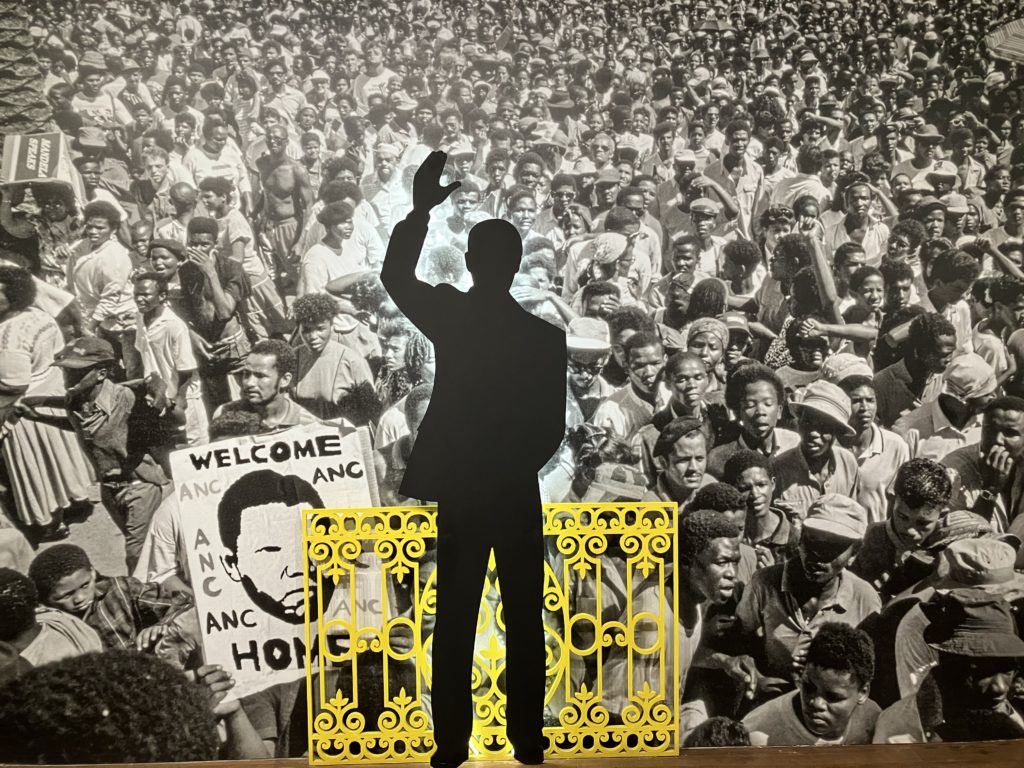
Photo: Nelson Mandela at Nelson Mandela Museum, Cape Town
I am tired even remembering the sights, sounds and stimulus of these first three days, not yet able to absorb all that we learned and felt. That third day, Sunday, I opted for a longish run instead of spending time in the artisan shops with my tour mates. The Promenade was crowded, certainly thousands of South Africans walking, bicycling, learning to bicycle, skate boarding, swimming in the cold pool near the beach, playing in the tide pools, eating ice cream. Here I was, in the middle of a foreign city on a hot and humid Sunday afternoon running and weaving among the crowd, stopping occasionally to delight in the children playing so freely, in couples holding hands, in para-gliders dotting the sky above the ocean. The light was heavenly, the sun bright, the sky brilliant blue, the clothes a kaleidoscope of colors, patterns, and shapes. I was grounded, safe, myself–even as I felt that self responding to an openness, a lightness that would only expand as my time in Africa continued.

Protea, abundant throughout South Africa, especially at our retreat center
Bodhi Khaya Nature Retreat, a Buddhist retreat center in the Overstrand valley, was about a 2 ½ hour drive from Cape Town (after our bus missed a turn and had to gingerly reverse course). It was our time to relax, participate in meditation-directed writing, engage in movement (Gyrokinesis, a form of movement that decompresses the body, using arch and curl techniques, rotation, gentle stretching), practice silence, and sit around glowing campfires in the dark African night, learning (slightly) to beat on African drums. I’d hoped there would be more creative writing, the ability to capture in words what I was experiencing physically and emotionally, but the writing was more a tool to think more deeply about ourselves. The retreat has walking trails that I’d thought I could run. Unfortunately, the retreat area also has very large gophers that leave huge, ankle-breaking mounds and holes throughout the property. The trails were prime gopher territory, barely walkable, certainly not runnable.
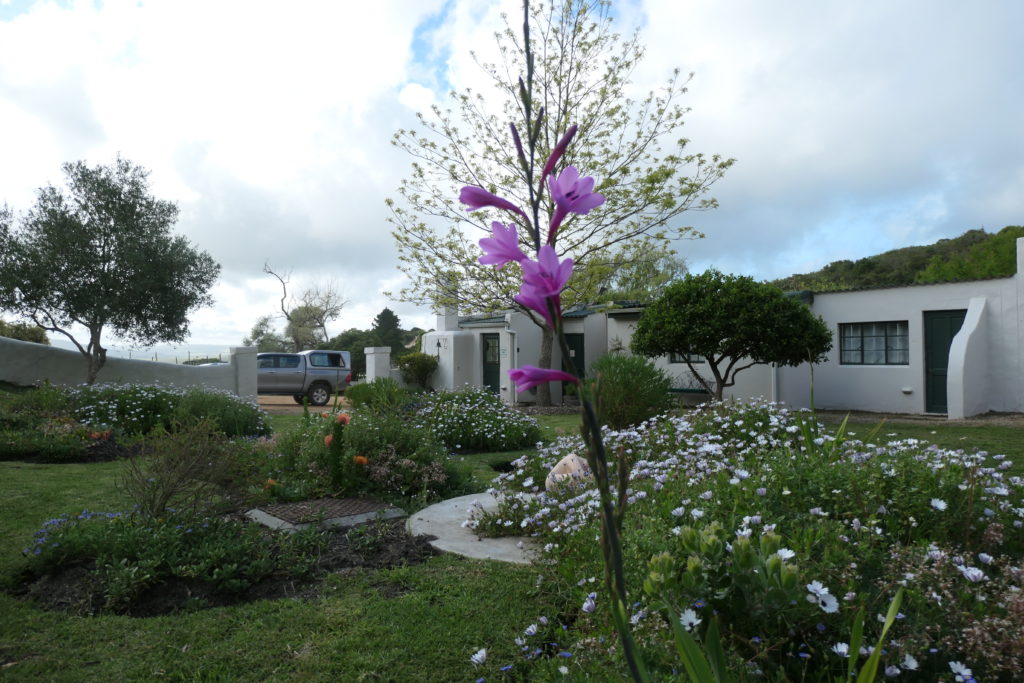
Bodhi Khaya Nature Retreat
Running at the retreat wouldn’t work, but I realized the hilly dirt road from the narrow highway into the valley could. In response to my concern about wild animals, I was told there were baboons but that they wouldn’t approach me. Taking the word of the retreat staff without question, I ran two mornings before our official days started. The views from the valley across the misted mountains to the bay were stunning, calming, enveloping. The birdsong as dawn turned to daylight was as if an orchestra was personally playing for me.
The first morning a group of children walking with their parents to work/school shyly said “hello.” Their smiles radiated warmth and friendliness. The second morning, cows and horses crowded up to the fences near the road to stare at me. I nodded (yes, to horses) and continued on the washboard road up the hill then back down the valley. My heart opened, my senses on high alert, the slight chill turning to warmth as the sun rose.
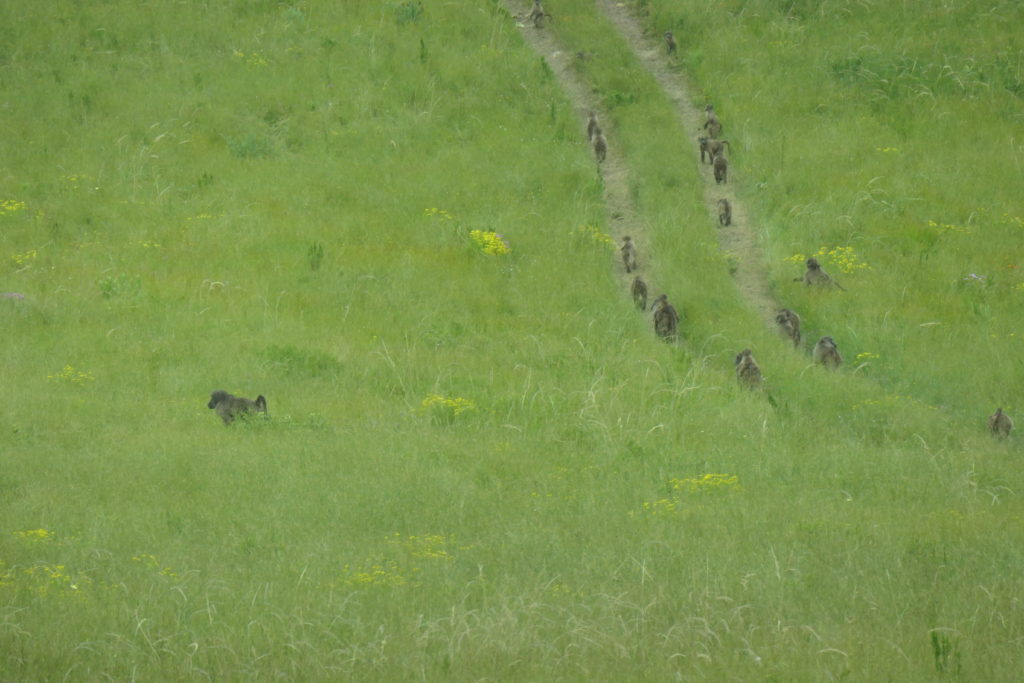
Baboons!!!!
Imagine my surprise as we left the retreat on the same road as I’d just be running where we encountered at least 50 baboons. The alpha male was focused, protecting all the little ones as they ran up the meadow beside the road. I’d take more seriously warning about wild animals out and about!
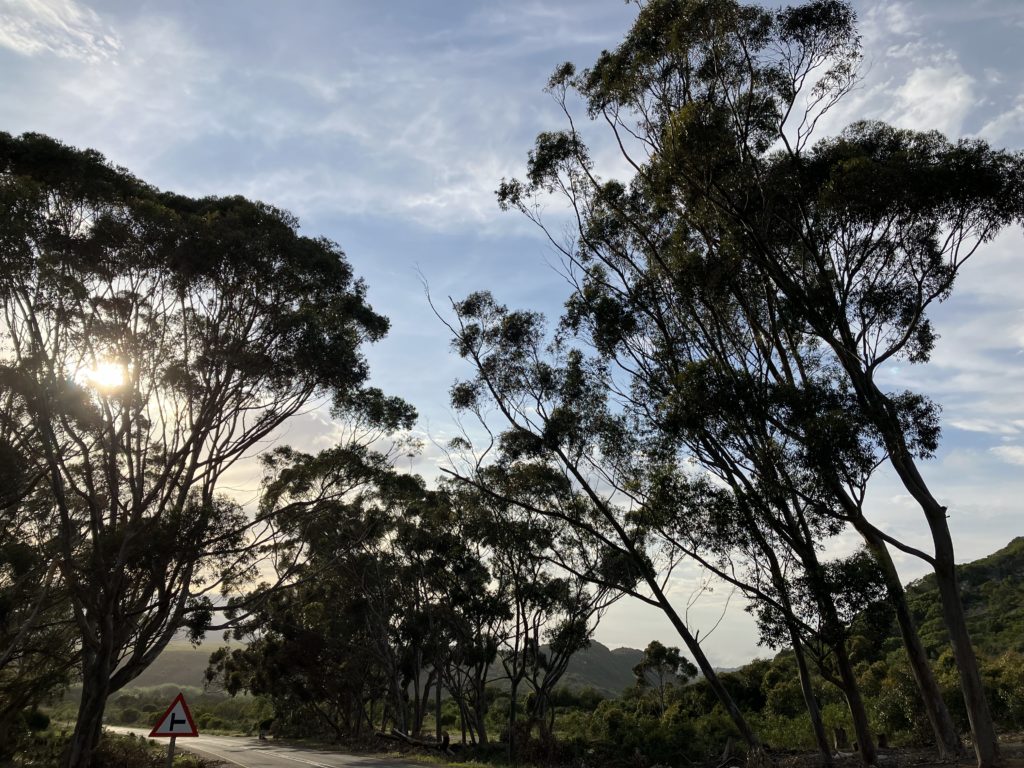
End of road near Bodhi Khaya Nature Retreat, Overstrand
We spent time in the West Cape wine country, staying at Franschhoek, a charming town of white Dutch-colonial style houses set against sharp 6,000’ high mountains and among verdant wine estates. The subject for another story, it felt like home, green, spring flowers in full bloom, wide-open sky, over 120 wine estates. Our stay was shorter than we’d hoped, but I did an early morning run through town, up the hills among the residential areas, and along the primary walking path from the bus stops to the center of town. I passed school children and workers on their way to the vineyards, shops, and businesses. Again, running gave me the opportunity to spend time “on the ground” among the South African people, not seeing them through the window of a bus or van. Most of them acknowledged me with a smile or nod, probably thinking, “a crazy white woman!” Another refreshing start to another busy day.
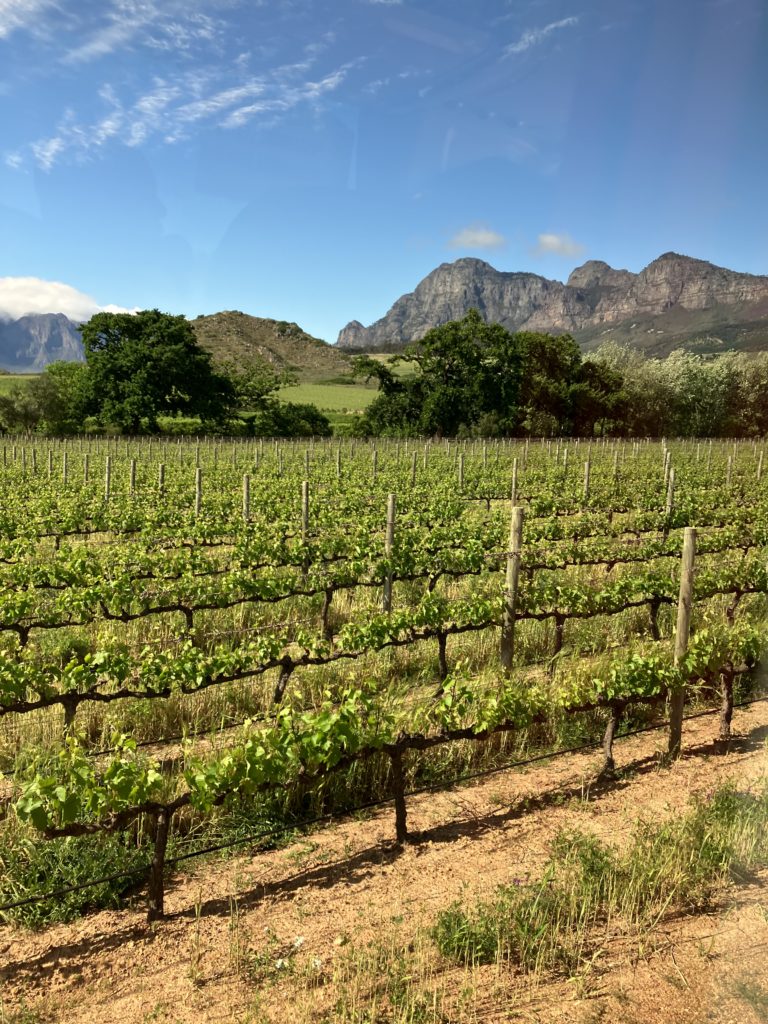
Wine Estate near Franschhoek
I knew I wouldn’t be able to run in the African bush. I’ve searched over the years for running safaris, mostly to no avail. The Idube Nature Retreat is conservation land, contiguous to Kruger National Park, home to a diverse spectrum of wild animals. We are only guests in this part of the country. We were required to have guides with us whenever we were out at night, even for the short walk from the dining room to our small rooms. Running, even walking, alone, was not permitted. Kudu, monkeys, Impala, and gazelles often gazed just outside my room.
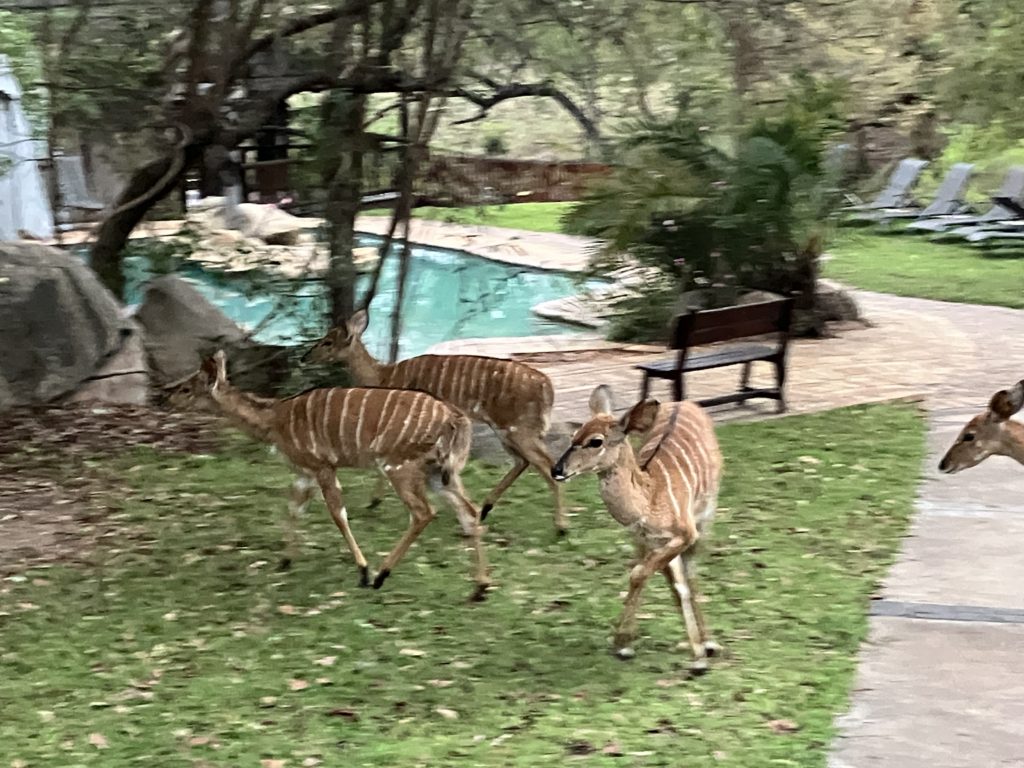
Female Nyala near our eating porch!
Spiders, millipeds, and other bugs were in my room. While in jeeps, we encountered sister lions, hyena, elephants, giraffes, zebras, too many elephants to count, leopard, etc. Even on our nature walks close to the lodge we were accompanied by armed guides, each with a huge rifle and huge bullets. It was apparent the dangers we might encounter in the bush on foot. You might enjoy my first story from South Africa, A GLORIOUS MORNING WALK: SURROUNDED BY ELEPHANTS in the bush, to see how surrounded we were whenever outside. This was not the place to run solo.I would enjoy this amazing, immense, vast, and reverent place without running.

The serenity of evening at Idube Nature Preserve
In all, I was able to run almost half of the days of my two-week retreat in the vastness that is South Africa. The journey was so much more than running, but the opportunities to keep a part of my daily life while experiencing such a different time and place helped ground me. For that I am grateful.
It’s been 15 years since my visit to South Africa. I found it difficult to plan and find a suitable area to run. I was firmly discouraged from running from the hotel and found myself one day running the corridors just to, well, just to run.
I love to run solo, but exercise caution regardless of where I am traveling, particularly when first arriving always remembering that I am a guest and a stranger in a new land.
This is a beautifully written article. Congratulations on putting together a trip that offers writing, meditation and time for exploration of this beautiful country.
Thank you, Mary Lou. Sounds like you’ve had some incredible hikes recently, too! My son and daughter-in-law went to book talks in Harrisburg last weekend while we watched the grandkids. Thought of you. Maybe we’ll meet some day in PA to run! Patricia
Glad you weren’t eaten by a lion on your runs!
We saw two lion sisters in the middle of the bush, hanging out, not bothering us. The male was nowhere around. We were not allowed out of the jeep except for coffee one morning. I tried to be careful and obey the rules!